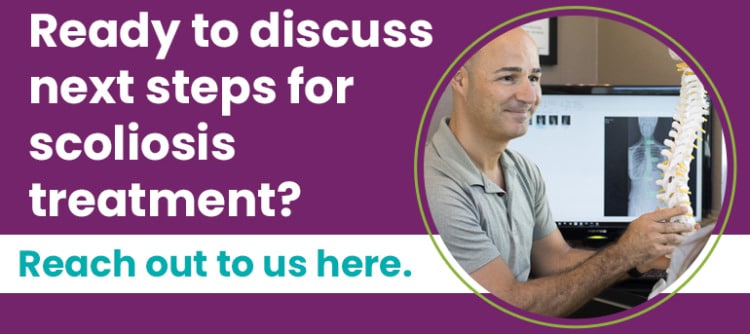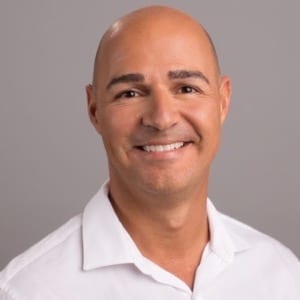Scoliosis and Muscle Weakness: Which Side Is Affected?
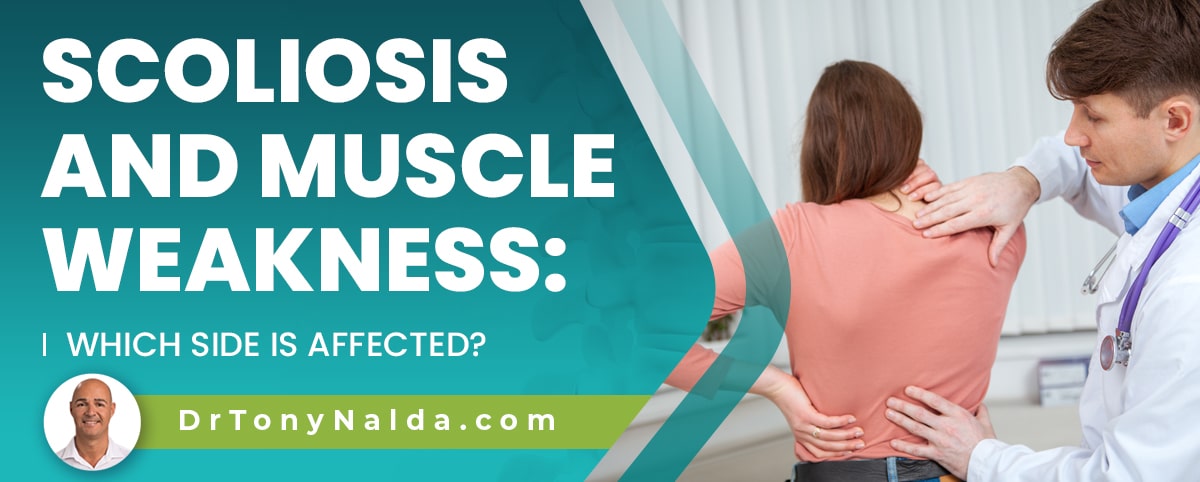
There are different severity levels of scoliosis, types of scoliosis, and scoliosis curves. In most cases of typical idiopathic scoliosis, curves bend to the right, away from the heart, and in particularly severe and/or atypical cases, curves can bend to the left, towards the heart. When the spine is bending and twisting unnaturally, it can pull its surrounding muscles in different directions causing a muscular imbalance to develop.
Scoliosis causes the spine to bend and twist unnaturally, and the condition's uneven forces don't just affect the spine, but also its surrounding muscles. Both sides of the body are affected, and a muscular imbalance is a common effect. With typical curves, muscles on the left side of the spine are weaker.
Let's explore the potential effects of scoliosis, starting with how the condition affects the spine's surrounding muscles and which side of the spine is weaker.
Table of Contents
Scoliosis and Muscle Strength
Scoliosis introduces a lot of uneven forces to the spine, its surrounding muscles and nerves, and the entire body.
As a progressive condition, the effects of scoliosis can get worse over time.
As scoliosis progresses, the spine's unnatural curve is getting larger, and this means the condition's uneven forces are also increasing, as are their effects.
Scoliosis can cause postural deviation, pain, muscle spasms and weakness, and the development of a muscular imbalance.
It's not just the spine that has to maintain its natural and healthy curves; it's also the responsibility of the spine's surrounding muscles to support and stabilize the spine.
If the spine is bent and twisted unnaturally, its surrounding muscles have to work harder to support it, and the muscles on one side will work harder to counteract the unnatural bend and twist.
Most cases of scoliosis involve typical right-bending idiopathic scoliosis curves, but in some particularly severe and/or atypical cases, curves can bend to the left, towards the heart.
As 80 percent of known cases involve idiopathic scoliosis, let's address which side is weaker in typical cases of right-bending idiopathic scoliosis curves.
Muscular Imbalance
When the spine bends unnaturally to the right, the muscles on the right side of the body and spine are going to have to work harder as they struggle to support the unnatural spinal curve; the muscles on the left side of the spine can become weak from lack of use.
This type of muscular imbalance can lead to painful spasms and muscle weakness, and along with the other condition effects, imbalanced muscles will get worse alongside progression.
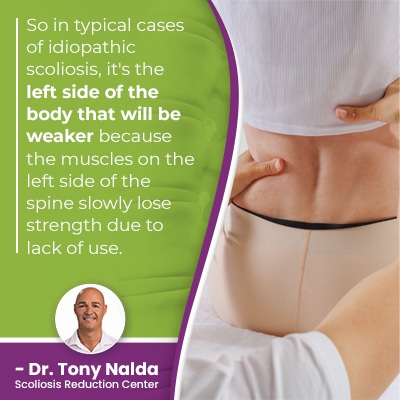 So in typical cases of idiopathic scoliosis, it's the left side of the body that will be weaker because the muscles on the left side of the spine slowly lose strength due to lack of use.
So in typical cases of idiopathic scoliosis, it's the left side of the body that will be weaker because the muscles on the left side of the spine slowly lose strength due to lack of use.
In atypical cases of scoliosis with left-bending curves, the right side of the body will be weaker because the muscles on the left side will work harder to counteract the spine's unnatural left-bend.
So in the majority of scoliosis patients, approximately 80 percent, the left side of the body will be weaker because the spine bends to the right so the body's right-sided muscles are working harder to counteract the spine's unnatural bend.
In addition to a muscular imbalance, additional condition effects include postural changes and pain.
Postural Changes
Scoliosis affects all ages, but as the condition is more commonly diagnosed in children, it's largely considered a childhood condition.
In addition, as scoliosis progression is triggered by growth, children are the most at risk for continued and rapid progression.
The main sign of scoliosis in children are postural changes such as uneven shoulders, uneven shoulder blades, uneven hips, the development of a rib cage arch, and arms and legs that hang at different lengths.
The more posture is disrupted, the more movement changes are also forthcoming; changes to gait, balance, and coordination are common.
The more severe scoliosis becomes, the more noticeable its effects become, and the more complex it is to treat.
Not only does the spine become increasingly rigid with progression, condition effects also become more established; it's more effective to proactively work towards preventing progression and increasing effects than it is to work towards reversing effects after they're established.
Postural changes can be subtle in mild scoliosis, which is why most of my patients are diagnosed with moderate scoliosis as it's when cases progress from mild to moderate that their symptoms become noticeable enough to lead to assessment and diagnosis.
In adults, it's most often pain that brings them in for assessment and diagnosis.
Scoliosis Pain
A scoliosis diagnosis doesn't mean a life of pain; in fact, children don't commonly find the condition painful.
Scoliosis doesn't become a compressive condition until skeletal maturity has been reached. When growth stops, the spine is no longer growing, and the constant lengthening motion of growth that once counteracted compression has stopped.
Compression is uneven pressure, and it's compression of the spine and its surrounding muscles and nerves that causes the majority of condition-related pain.
Scoliosis pain can involve muscle pain, imbalance, and weakness, back pain, and pain that radiates into the extremities due to nerve compression.
Chronic back pain is a common effect of severe adult scoliosis, and as progression occurs, the spine loses flexibility and becomes less responsive to treatment.
Strong abdominal muscles means a spine that can be well supported, and a spine that's surrounded by strong balanced and symmetrical muscles is a spine that's well supported.
How is a Scoliosis Muscular Imbalance Treated?
Muscles that become weak and unbalanced need to be addressed as part of a proactive scoliosis treatment approach.
Muscle atrophy can be prevented by restoring the spine's surrounding muscle strength and symmetry.
A key facet of non-surgical scoliosis treatment is exercise-based; physical therapy is applied to improve the spine's surrounding muscle balance and strength.
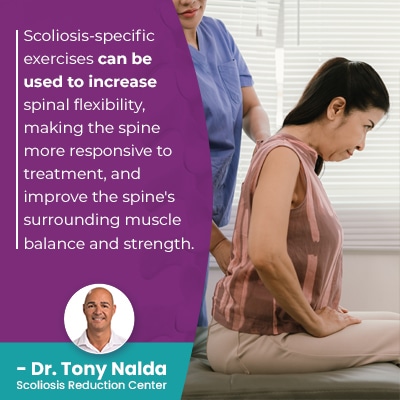 Scoliosis-specific exercises can be used to increase spinal flexibility, making the spine more responsive to treatment, and improve the spine's surrounding muscle balance and strength.
Scoliosis-specific exercises can be used to increase spinal flexibility, making the spine more responsive to treatment, and improve the spine's surrounding muscle balance and strength.
Mirror-image scoliosis exercises can also help with postural awareness and remodeling so patients know how to hold their spines and bodies to sustain treatment results.
If muscles on the left side of the spine have become weak and small, targeted strength building with therapeutic exercises and stretches can help.
For tight and sore muscles on the right side of the spine, gentle stretching can help.
The best way to minimize the potential effects of scoliosis, including weak and unbalanced muscles, is to treat conditions proactively because the weak muscles are a symptom of scoliosis.
Treating scoliosis proactively means starting treatment immediately following a diagnosis with the goal of preventing progression, increasing condition effects, and the need for invasive surgical treatment.
Spinal Fusion Surgery
The two main scoliosis treatment choices include traditional spinal fusion surgery and modern conservative non-surgical treatment.
When it comes to traditional scoliosis surgery, this is commonly recommended for severe scoliosis patients and involves fusing the curve's most-tilted vertebrae into old solid bone, but accessing the spine in this manner can involve cutting through muscle.
While there are different types of surgery with some muscle-sparring techniques, spinal fusion recovery time involves muscle tissue repair and healing, which can be lengthy.
Conclusion
With scoliosis, the spine bends unnaturally to the side and rotates, and in most cases, scoliosis curves bend to the right, so the left side will be weaker because the muscles on the right side are working harder.
In cases of atypical levoscoliosis where curves bend to the left, the right side will be weaker because the muscles on the left side of the spine are working harder to counteract the unnatural bend.
The goal of scoliosis treatment is to prevent progression and increasing condition effects caused by the condition's increasing uneven forces, and reducing the size of the unnatural spinal curve means restoring as much of the spine's natural and healthy curve as possible.
A conservative scoliosis treatment approach is proactive treatment because it's started as close to the time of diagnosis as possible, and a scoliotic spine is going to be more responsive while conditions are still mild.
Scoliosis can develop in any of the spine's main sections: the cervical spine, thoracic spine, and the lumbar spine.
A muscle imbalance is a condition effect that can get worse over time, and in untreated scoliosis patients, complications can develop such as breathing and digestive problems.
As an unnatural spinal curve develops, the body is being exposed to uneven forces that can disrupt the body's alignment from the head to the feet and a misaligned spine doesn't just affect the spine but also the muscles that surround it.
Strong surrounding muscles are needed for spinal support and stability, which is why physical therapy and scoliosis-specific exercise are such valuable facets of treatment.
Here at the Scoliosis Reduction Center®, scoliosis patients benefit from a multi-faceted treatment approach with proven results.
Dr. Tony Nalda
DOCTOR OF CHIROPRACTIC
After receiving an undergraduate degree in psychology and his Doctorate of Chiropractic from Life University, Dr. Nalda settled in Celebration, Florida and proceeded to build one of Central Florida’s most successful chiropractic clinics.
His experience with patients suffering from scoliosis, and the confusion and frustration they faced, led him to seek a specialty in scoliosis care. In 2006 he completed his Intensive Care Certification from CLEAR Institute, a leading scoliosis educational and certification center.
About Dr. Tony Nalda
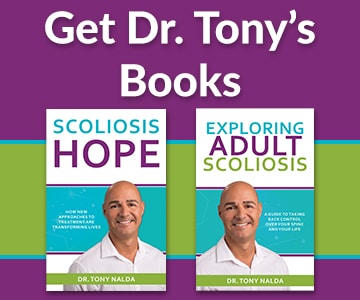 Ready to explore scoliosis treatment? Contact Us Now
Ready to explore scoliosis treatment? Contact Us Now